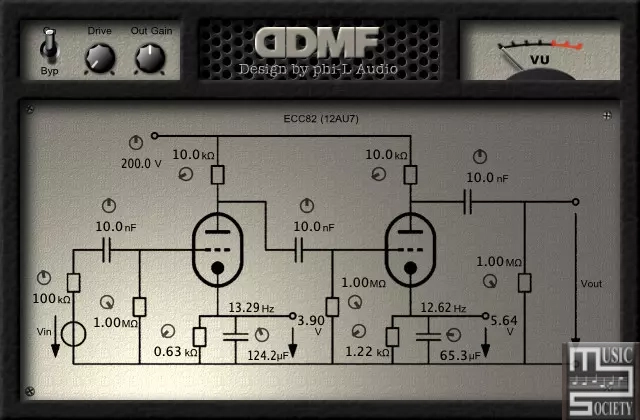
This tube preamp emulation has been developed Philipp Bulling as a thesis work. Philipp has been offering the plugin in VST format for some time on his own website. He has now moved on to new areas for some time already but didn’t want to let down his users. Hence, DDMF took over the code and will continue to offer the plugin as freeware, with the intent to further improve it and maybe add some more bells and whistles in the future.
The plugin is very unique in the sense that it gives you full control over all aspects of the modelled circuit. All values of all the capacitors, resistors etc. can be tuned by the user. Here is what Philipp had written on the original page.
Abstract
Since the sound of an analogue tube amplifier has always exerted a strong fascination, electrical circuits with tubes play a certain role in the world of audio engineering up to now. On the other hand, audio technology becomes more and more digitised. In many cases, digital models emulate real devices in such a way that differences in sound are hardly audible. In this work a model is developed which is able to emulate the typical sound of a tube amplifier on digital devices. Here the main focus is on preamplifiers with triodes, since they have a particular influence to the sound.
Based on the physical properties of real tubes, a tube model is developed first. This mathematical model includes results of theoretical studies as well as analysis of data sheets. The model is then used to implement an entire amplifier circuit. In addition to the tube itself amplifier circuits contain several passive elements. In the domain of digital signal processing the latter are described by finite difference equations, which are solved recursively.
The resulting algorithm is finally implemented as an audio plugin in order to examine its tonal properties. The behavior of the digital model corresponds satisfactorily to real amplifier circuits. Important sound effects of analogue tube amplifiers can also be attested to the digital model.
Diode model
The first step was to develop a triode model, based on the characteristic curves of real tubes. In theory, the characteristic curve of a vacuum tube is described by Langmuir-Child’s law. However, it was quickly realised that compared to real tubes, this law is not accurate enough. So a new model has been developed. This model describes a triode as a mathematical function. With the model, it is possible to compute the plate voltage (Upc) as a function of the grid voltage (Ugc), depending on the working resistor (Ra) and the supply voltage (Ub).
The following graph shows this function for a 12AU7 triode with Ra = 10k and Ub = 250V:




